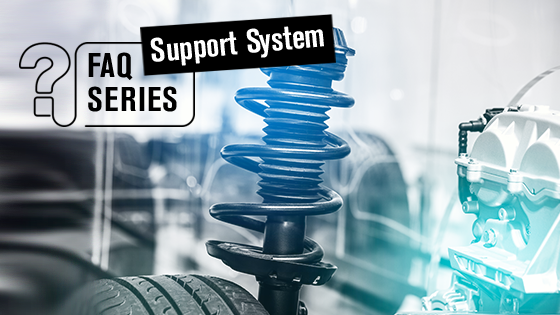The support system in a vehicle serves many purposes and can be known by a couple different names. You might be familiar with the “suspension system” in a car, which can be interchangeable for the overarching “support system” terminology. The main functions of this system contribute to the road handling, safety, and comfort of any vehicle. To understand the purpose of these functions, let’s delve into a better understanding of some different parts that make up the suspension system that contribute overall to support your car.
The frame. This is the structural, load-carrying component that supports a vehicle’s engine and body which the support (suspension) system then reinforces.
Springs. Nowadays, spring systems pretty much have four basic designs that contribute to the car’s balance and passenger comfort. The most common type of springs found in the support system are either coil springs, leaf springs, torsion bars, or air springs. You can find most springs located between the wheels and the frame of a car. Overall, they serve to compress and expand to absorb the motion of the wheels, thus contributing to the road handling and comfort results.
Dampers (i.e. shock absorbers). You just learned about springs, which allow the wheels to move up to absorb bumps in the road and improve the handling of the vehicle. Now we’re talking about dampers, which are commonly called shock absorbers and/or “shocks” or “struts”. They go hand-in-hand with springs to prevent your car from bouncing up and down. While the springs are necessary to deflect the bounce, your car would continue to bounce up and down if the reaction from these springs was not dissipated by dampers being in place. The “shock absorber” is a device that helps control this spring motion through an overall process known as “dampening.” Thus the term, dampers.
Stabilizers. These are found in most cars, however, not all. You can hear many different terms when it comes to stabilizers, such as anti-sway bars, sway bars, stabilizer bars, and anti-roll bars. These are all essentially the same thing. Stabilizers serve as a bar between the front wheels and rear wheels that provide another dampening function and overall structural car support. Stabilizers serve to prevent leaning/swaying of your vehicle during turns and resist the swaying movement to keep your car’s wheels at the same height. Depending on the make and model of your car, these bars will vary from a thick/stiff bar to less rigid bars (which are better for off-roading).
Tires and wheels. These obviously are an essential component that support your car. They help provide the traction, grip and friction that make movement of your vehicle possible.





No Comments